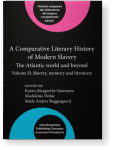Chapter 10
Reimagining slavery from a twenty-first-century perspective
Yaa Gyasi’s Homegoing (2016) and Colson Whitehead’s The Underground Railroad
(2016)
This chapter focuses on two historical novels that were published in 2016 to great acclaim: Colson
Whitehead’s The Underground Railroad and Yaa Gyasi’s Homegoing (re)imagine slavery from a twenty-first-century
perspective. The chapter analyzes the novels’ literary representation of the Atlantic slave trade and slavery and
identifies common tropes, metaphors, and images used to convey the traumatic past. It posits that literary approaches
to the subject reveal a contemporary desire to revisit the past to address larger social, ideological, and political
contexts and discourses that define the present moment. Moreover, it shows that both novels self-consciously reflect
on the politics of remembrance and history writing.
Article outline
- (Re)Turning to the past
- Tracing the legacy of slavery on both sides of the Atlantic ocean in Yaa Gyasi’s Homegoing
- Touring landscapes of American slavery: Colson Whitehead’s The Underground Railroad
- Conclusion
- Author queries
-
Notes
-
References
This content is being prepared for publication; it may be subject to changes.
